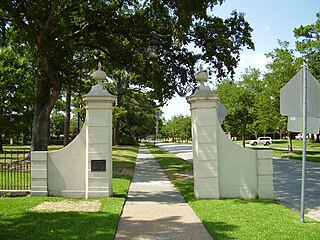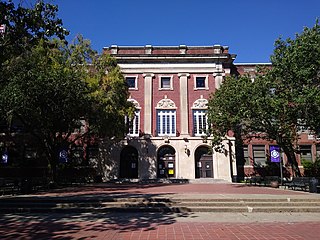
River Oaks is a residential community located in the center of Houston, Texas, United States. Located within the 610 Loop and between Downtown and Uptown, the community spans 1,100 acres (450 ha). Established in the 1920s by brothers Will Hogg and Michael Hogg, the community became a well-publicized national model for community planning. Real estate values in the community range from $1 million to over $20 million. River Oaks was also named the most expensive neighborhood in Houston in 2013. The community is home to River Oaks Country Club, which includes a golf course designed by architect Donald Ross and redesigned in 2015 by Tom Fazio.

Bob Lanier Middle School, formerly Sidney Lanier Junior High School/Middle School, is a middle school in Houston, Texas, United States, with a ZIP code of 77098. Lanier, a school of the Houston Independent School District (HISD), handles grades 6 through 8. Named after former mayor of Houston Bob Lanier, the school is located in Neartown and near Montrose and has both neighborhood non-magnet and Vanguard/IBMYP gifted/talented programs. Lanier's neighborhood program serves Montrose, Afton Oaks, Boulevard Oaks, River Oaks, Southampton, and other communities.

Glenwood Cemetery is located in Houston, Texas, United States. Developed in 1871, the first professionally designed cemetery in the city accepted its first burial in 1872. Its location at Washington Avenue overlooking Buffalo Bayou served as an entertainment attraction in the 1880s. The design was based on principles for garden cemeteries, breaking the pattern of the typical gridiron layouts of most Houston cemeteries. Many influential people lay to rest at Glenwood, making it the "River Oaks of the dead." As of 2018, Glenwood includes the annexed property of the adjacent Washington Cemetery, creating a total area of 84 acres (34 ha) with 18 acres (7.3 ha) still undeveloped.

Southampton Place, also known as Southampton, is a neighborhood located in Houston, Texas. The Southampton Civic Club Inc. is the homeowners' association.

Boulevard Oaks is a neighborhood in Houston, Texas, United States, containing 21 subdivisions north of Rice University and south of U.S. Highway 59. Developed primarily during the 1920s and 1930s, Boulevard Oaks contains two National Register historic districts, Broadacres and Boulevard Oaks. The Boulevard Oaks Civic Association (BOCA) is the common civic association for all 21 subdivisions.

Edgar Allan Poe Elementary School is a primary school located at 5100 Hazard Street in Houston, Texas, United States. A part of the Houston Independent School District (HISD), the school, which was built during the 1920s, is located in the Chevy Chase subdivision of the Boulevard Oaks neighborhood west of Rice University. The school, a National Register of Historic Places (NRHP) historic district contributing property of Boulevard Oaks, was named after Edgar Allan Poe.

John Fanz Staub was an American residential architect who designed numerous traditionally-styled homes and mansions, mostly in Houston, Texas from the 1920s to 1960s. He was a grandson of Peter Staub, who served as U.S. consul to St. Gallen, Switzerland.

James Addison Baker was an American attorney and banker in Houston, Texas. He was born James Addison Baker, Junior, and "Junior" appeared in his signature for many years. After the death of his father in 1897, he started signing his name "Captain James A. Baker," and from that point on people referred to him as Captain Baker.

James Addison Baker was a state legislator, state judge, and a lawyer. He is the first of four generations of persons named James Addison Baker, all of whom practiced law. He was known as "Judge Baker" after 1864. His son, also named James A. Baker, was a personal attorney for William Marsh Rice; and his great-grandson is James Baker, former President's Chief of Staff and former Secretary of State.
James Addison Baker Jr. was an American attorney, banker, real estate developer, and United States Army officer from Houston, Texas. He was the third in a succession of men named James Addison Baker, all of whom were attorneys for Baker Botts or its antecedents. His son is James Addison Baker III, former United States Secretary of State.

Alfred Charles Finn was an American architect. He started in the profession with no formal training in 1904 as an apprentice for Sanguinet & Staats. He worked in their offices in Dallas, Fort Worth, and Houston. His credits during his tenure residential structures, but firm was a leader in steel-frame construction of skyscrapers.
The campus of Rice University is located on a heavily wooded 290-acre (120-hectare) plot of land on South Main Street in the Museum District of Houston, Texas. It is located east of Rice Village, a retail district, south of Boulevard Oaks and Southampton, west of the Texas Medical Center, and north of Southgate.
Frank Prior Sterling was an American oilman and oil industry businessperson, based in Houston, Texas.

The Hogg Building, also known as the Hogg Palace, is a building located at 401 Louisiana in Downtown Houston, Texas, and is listed on the National Register of Historic Places.
Stablewood is a 72-acre (29 ha) community in Houston, just outside the 610 Loop. It is in proximity to the Houstonian Hotel, Club, and Spa.

Ella J. Baker Montessori School, formerly Woodrow Wilson Montessori School and Woodrow Wilson Elementary School, is a public K-8 Montessori school in the Cherryhurst Addition subdivision in the Neartown area of Houston, Texas. A part of the Houston Independent School District (HISD), Baker serves as the neighborhood elementary school for a section of Neartown, including a portion of Montrose. It also serves as a magnet school for all of HISD's territory. As of 2014 it is one of three public Montessori programs in Houston. It was the first HISD school to use the Montessori style for all students, as well as housing HISD's first Montessori middle school program.
Courtlandt Place, Houston is a residential subdivision consisting of a single street, south of downtown Houston, planned in 1906. Courtlandt Place is a member of the Neartown Houston Association.
Birdsall Parmenas Briscoe was an American architect active in Texas, especially in Houston. He was known as "Birdsall Briscoe" or "Birdsall P. Briscoe". Several of his works have been listed on the U.S. National Register of Historic Places for their architecture.
Alice Graham Baker was an American civic leader, social worker, and philanthropist. She was the founding president of the Houston Settlement Association. She was married to Captain James A. Baker, who collaborated with her in civic ventures. She was the grandmother of James Addison Baker III, former United States Secretary of State and former Secretary of Treasury.
BakerRipley is a non-profit corporation based in Houston. The organization has also been known as the Houston Settlement Association, Neighborhood Centers, and Neighborhood Centers, Inc. In 1940, the Houston Settlement Association brought the Ripley Foundation into its organization. In 2018, BakerRipley has seventy locations in the Houston region.


















